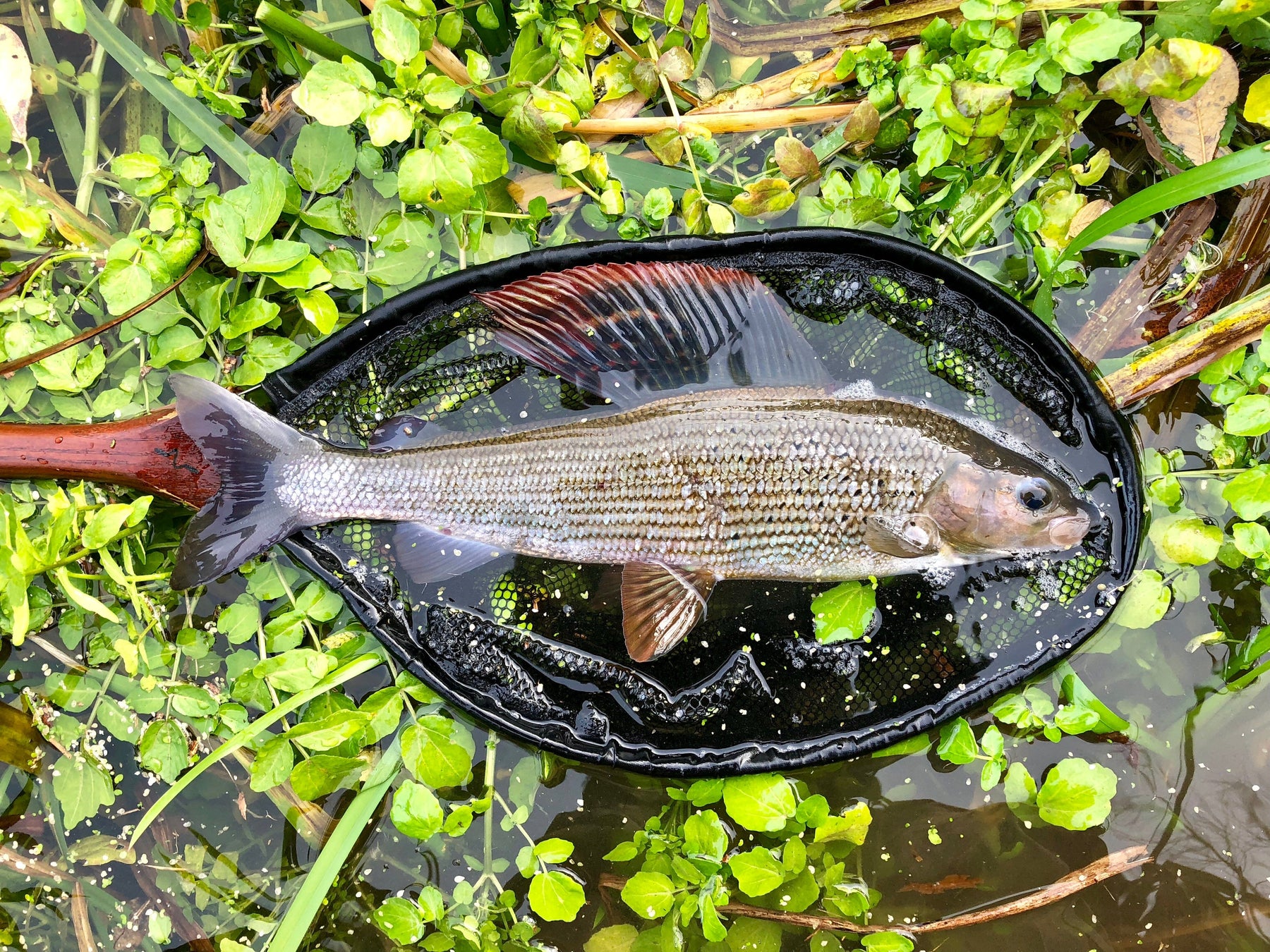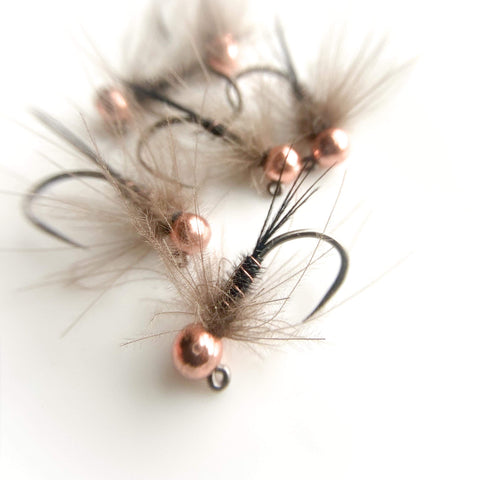
The Best Competition Grayling Flies You Must Try
For this month's blog, we have asked our consultant team and guests to provide their top flies for winter Graying. Some of the contributors include anglers who have competed at the highest levels, including the World and European Championships, and they have kindly agreed to share patterns that they have developed and used to great success over the years. Don't forget to use discount code WELCOME10 for 10% off your first order at Upavon Fly Fishing.
1. Lewis Hendrie - The Pixie

I tie the Pixie with a range of bead colours. After several years of testing, I have selected my chosen few. For clear water, I use copper, natural tungsten, black nickel, and orange for days when the water is coloured. The orange bead is also effective around the salmon spawn as the colour represents the high-protein salmon eggs that many fish will feed on.
Recipe
Hook: #12-18 Czech Nymph HookBead: Upavon Slotted Metallic Tungsten Bead Copper, Black Nickel (Size to suit situation)
Thread: Glo Brite No.7
Flashback: Medium Gold Holographic Tinsel
Body: Natural Hares ear
Rib: Glo Brite No.7
2. Andy Taylor - Tangerine Terror F Fly
The Tangerine Terror is one of my favourite dry flies for Grayling. I tie it in 3 different variations. Although this may seem excessive, they all have their own purpose and place in my box. Firstly, the seal's fur body. The seal fur version works best in glides with a riffled surface as the fly sits higher in the surface film and has more of a profile. The seal fur takes liquid floatant well, with the composition of the dubbing allowing the fly to dry quickly and easily after each fish.

The second version is the Glo Brite and Holographic. In bright conditions I like my dry flies to have something extra to catch the fish's attention. In cases such as this, an orange holographic butt is a great option. The holographic butt remains subtle yet will still provide an additional trigger when it catches the light. The body on this version is Glo Brite No.7. This version still maintains the orange colour scheme. However, unlike its seal fur counterpart, the holographic tag version will sit lower in the surface film.
Finally, when fishing slow glides, I like to use the Glo Brite body version of the Tangerine Terror. Similarly to the holographic version, this variation will sit lower in the surface film and present better in the smoother surface film.
Recipe
Hook: Dry Fly Hook #16-18Thread: Orange
Body: Orange Seals fur or Glo Brite No.7
Tag: Orange Holographic (For Terror version 2)
Wing: Upavon Natural Grey CDC
Thorax: Orange Seals Fur
3. Nathan Gittings - Black Pheasant Tail

Pheasant Tail is one of my favourite materials for river nymphs. Its composition and appearance on a fly represent natural insect bodies incredibly well. When targeting Grayling on any river I often fish nymphs with dark or black bodies. Confidence in the patterns definitely plays a key role. However, especially on my local rivers in South Wales, I find black works best due to the substrate of the river. My black pheasant tail is about as simple as they come, using just a couple of materials. I do believe that we overcomplicate flies at times. More technical patterns do have their place, but, simple flies like this will often match or in some cases out fish more complex patterns.
Recipe
Hook: Jig hook #12-20Bead: Upavon Slotted Metallic Tungsten Bead Copper (Size to suit situation)
Thread: Black
Tail: Black Pheasant tail fibres
Rib: Copper Wire
Body: Black Pheasant tail fibres
Thorax: Upavon Natural Grey CDC
4. Ben Beckwith - Pink Tag
It is no secret that Grayling love the colour pink. Hence, the pink tag is a pattern found in every Grayling anglers fly box in one variation or another. Arguably, this pink tag represents everything and nothing. Nonetheless, a take on this classic has been very effective over the last couple of seasons, accounting for some great sessions on the river. Again, similarly to Nathan, I too have a lot of success using black flies for Grayling. For the body, I have combined our natural hollow dub with apex predator dubbing. It is an 80/20 split with the majority natural fibre. Similar to some of the other consultants, most of my flies incorporate small trigger points or elements that help te fly stand out to the fish. I have found the subtle assition of flash in natural bodies to be very effective, expecially for Grayling that have seen a lot of flies. I like to cut fibres from Upavon's super bright Pure Fritz material to use as a tag - there's nothing quite like it.

Recipe
Hook: Jig hook #12-20Bead: Upavon Slotted Metallic Tungsten Bead Silver (Size to suit situation)
Thread: Black
Tag: Upavon Pure Blob Fritz Pink
Rib: Silver wire
Body: Upavon Hollow Dub Black and Apex Predator Dubbing White Magic 80/20 Mix.
Hackle: Upavon Natural Grey CDC
Thorax: Apex Predator Dubbing Bronze
5. Lindsay Simpson - Mary Nymph
One of the top patterns on the River Avon, the Mary Nymph is best tied on small hooks and imitates a broad range of invertebrates. Used as a point fly on the Duo, or as a team with different colour beads for light nymphing techniques, this fly is a consistent performer. When tying the Mary Nymph I try to maintain a slender profile, using the minimum number of thread and material turns. The bead size is linked to the type of dry you want to suspend it from, I like to weigh my flies and annotate them on my fly boxes.

Recipe
Hook: Size 20-16 nymph hookBead: 2mm Countersunk Tungsten Bead (gold or pink)
Thread: Olive or brown Nanosilk
Tag: Coq de Leon
Rib: Gold Wire
Body: Natural Pheasant Tail
Thorax: Hares Ear with an Irese wing case
6. Ben Worley - The Copper Magellan

Named the Copper Magellan because it travels so well, this fly has caught fish across Europe and N.America. Now enhanced with new materials, this jig nymph consists of subtle colour combinations with a white tag making it equally effective in clear or coloured water. I like to fish it alone or with a shrimp dropper either dead drifted or jigged along the bottom to induce a take. This fly is particularly effective on the lift, so be sure to fish it right to the surface. Tying is made simple with the application of the Nymph-it thread on a bobbin as an easy alternative to copper wire.
Recipe
Enjoy this article? Please check out our back catalogue in the website blog area and use discount code WELCOME10 for 10% off your first order with Upavon.
Leave a comment